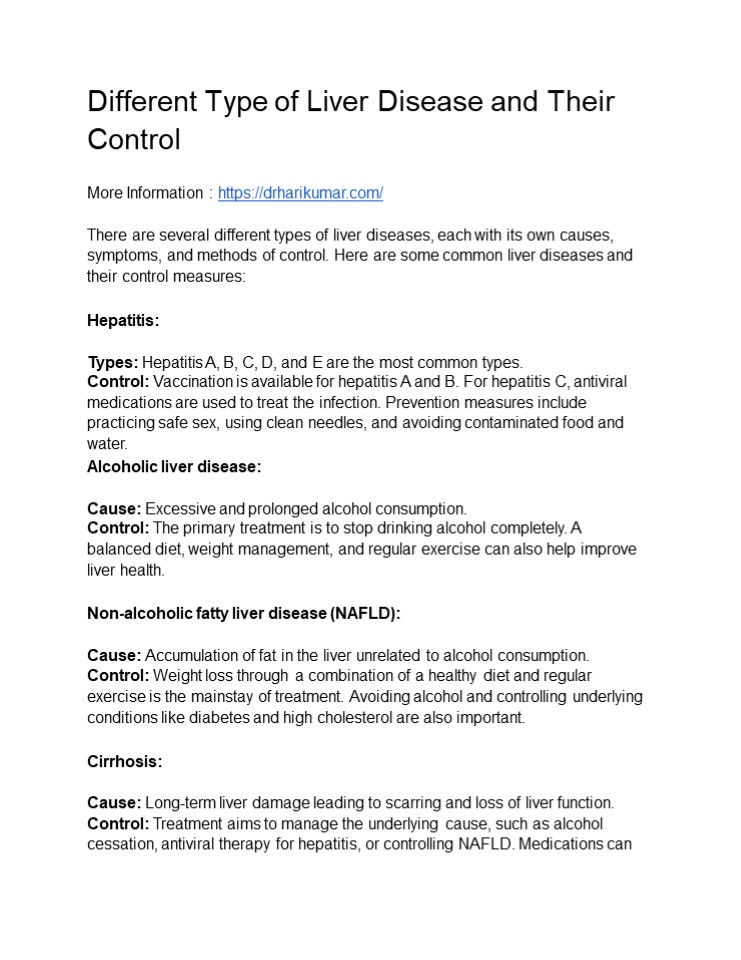Liver Specialist in Kochi - PowerPoint PPT Presentation
Title:
Liver Specialist in Kochi
Description:
Looking for expert liver care in Kerala? Our team of highly skilled and experienced liver specialists is dedicated to providing comprehensive diagnosis, treatment, and management of liver conditions. With a patient-centered approach, we offer advanced medical expertise in the field of hepatology, including liver diseases, liver cancer, viral hepatitis, cirrhosis, and liver transplantation. We prioritize patient education, personalized care, and the latest evidence-based treatments to ensure optimal liver health. Trust our liver specialists to provide compassionate care and guide you towards better liver wellness – PowerPoint PPT presentation
Number of Views:0
Title: Liver Specialist in Kochi
1
Different Type of Liver Disease and Their Control
More Information https//drharikumar.com/ There
are several different types of liver diseases,
each with its own causes, symptoms, and methods
of control. Here are some common liver diseases
and their control measures Hepatitis Types
Hepatitis A, B, C, D, and E are the most common
types. Control Vaccination is available for
hepatitis A and B. For hepatitis C, antiviral
medications are used to treat the infection.
Prevention measures include practicing safe sex,
using clean needles, and avoiding contaminated
food and water. Alcoholic liver disease Cause
Excessive and prolonged alcohol
consumption. Control The primary treatment is to
stop drinking alcohol completely. A balanced
diet, weight management, and regular exercise can
also help improve liver health. Non-alcoholic
fatty liver disease (NAFLD) Cause Accumulation
of fat in the liver unrelated to alcohol
consumption. Control Weight loss through a
combination of a healthy diet and regular
exercise is the mainstay of treatment. Avoiding
alcohol and controlling underlying conditions
like diabetes and high cholesterol are also
important. Cirrhosis Cause Long-term liver
damage leading to scarring and loss of liver
function. Control Treatment aims to manage the
underlying cause, such as alcohol cessation,
antiviral therapy for hepatitis, or controlling
NAFLD. Medications can
2
be prescribed to manage symptoms, and in some
cases, a liver transplant may be
necessary. Autoimmune hepatitis Cause The
immune system mistakenly attacks the
liver. Control Treatment typically involves
long-term immunosuppressive medications to
reduce liver inflammation. Regular monitoring of
liver function is important. Wilson's
disease Cause Inherited disorder that leads to
the accumulation of copper in the liver and
other organs. Control Treatment involves
medications to remove excess copper from the
body and manage its accumulation. Lifelong
therapy is necessary. Hemochromatosis Cause
Genetic disorder resulting in excessive iron
absorption and deposition in the liver. Control
Treatment involves periodic removal of blood
(phlebotomy) to reduce iron levels. Dietary
changes and avoidance of iron supplements are
also recommended. It's important to note that
the control measures mentioned above are general
recommendations. The specific treatment plan and
control measures for liver diseases may vary
depending on the individual, severity of the
disease, and the advice of healthcare
professionals. It's always best to consult with a
healthcare provider for an accurate diagnosis
and personalized treatment plan.































